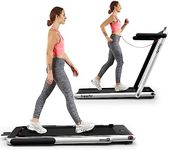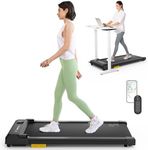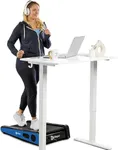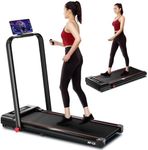Buying Guide for the Best Walking Treadmill For Desk
Choosing a walking treadmill for your desk is a great way to stay active while working. The right treadmill can help you maintain your health, boost your energy, and make your workday more dynamic. When picking a treadmill for this purpose, it's important to focus on features that match your workspace, walking habits, and comfort needs. Understanding the key specifications will help you find a treadmill that fits seamlessly into your daily routine and supports your wellness goals.Motor PowerMotor power, usually measured in horsepower (HP), determines how smoothly and quietly the treadmill runs. For desk walking, you don't need a very powerful motor, but it should be strong enough to handle continuous use at low speeds. Motors under 2.0 HP are common for walking treadmills, with lower values being quieter but possibly less durable for heavier users or longer sessions. If you plan to walk for several hours a day or if multiple people will use the treadmill, a slightly higher motor power can offer better longevity and performance.
Speed RangeThe speed range tells you how fast or slow the treadmill can go. For under-desk walking, most people prefer a range that starts very low (around 0.5 mph) and goes up to about 4 mph. Lower speeds are ideal for working while walking, as they allow you to type and focus without losing balance. If you want the option to walk briskly during breaks, look for a treadmill that can reach the higher end of this range. Think about your comfort level and how you plan to use the treadmill throughout your workday.
Deck SizeDeck size refers to the length and width of the walking surface. A wider and longer deck gives you more room to walk comfortably, especially if you have a longer stride. However, a larger deck also means the treadmill will take up more space under your desk. For most users, a deck width of 16-20 inches and a length of 40-50 inches is sufficient for walking. Consider your available space and your walking style when choosing the right deck size.
Noise LevelNoise level is important if you work in a shared space or need to make calls while walking. Quieter treadmills make it easier to concentrate and avoid disturbing others. Noise is influenced by the motor, belt, and overall build quality. Look for models that specifically mention quiet operation, and check user reviews for real-world feedback. If you are sensitive to noise or work in a quiet office, prioritize this feature.
Weight CapacityWeight capacity indicates the maximum user weight the treadmill can safely support. It's important to choose a treadmill with a weight limit that comfortably exceeds your own weight to ensure safety and durability. Most under-desk treadmills support between 200 and 300 pounds. If you are close to the upper limit, opt for a treadmill with a higher capacity for better performance and longevity.
Portability and StoragePortability and storage features, such as wheels or a foldable design, make it easier to move the treadmill when not in use. If you need to store the treadmill away at the end of the day or share your workspace, look for a lightweight model with built-in wheels. Consider how often you'll need to move the treadmill and how much space you have for storage.
Control and DisplayThe control and display system lets you adjust speed and track your progress. Some treadmills have remote controls, while others have built-in touch panels. Displays may show speed, time, distance, and calories burned. Choose a control system that is easy to use without interrupting your workflow. If you like to monitor your activity, look for a clear, accessible display.



















